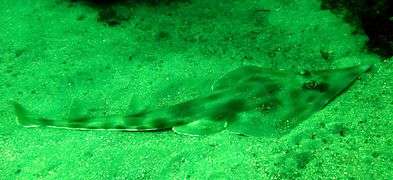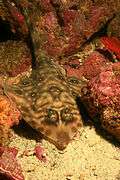Guitarfish
| Guitarfish Temporal range: Upper Jurassic–Recent | |
|---|---|
| | |
| Shovelnose guitarfish, Rhinobatos productus | |
| Scientific classification | |
| Kingdom: | Animalia |
| Phylum: | Chordata |
| Class: | Chondrichthyes |
| Subclass: | Elasmobranchii |
| Order: | Rajiformes |
| Family: | Rhinobatidae J. P. Müller & Henle, 1837 |
| Genera | |
|
See text. | |
The guitarfish are a family, Rhinobatidae, of rays. The guitarfish are known for an elongated body with a flattened head and trunk and small, ray-like wings. The combined range of the various species is tropical, subtropical, and temperate waters worldwide. They often travel in large schools.
Description
Guitarfish have a body form intermediate between those of sharks and rays. The tail has a typical shark-like form, but in many species, the head has a triangular, or guitar-like shape, rather than the disc-shape formed by fusion with the pectoral fins found in other rays.[2]
Reproduction
Guitarfish are ovoviviparous; the embryo matures inside an egg inside the mother until it is ready to hatch. This is typical of rays.
Habitat
Guitarfish are bottom feeders, which bury themselves in mud or sand and eat worms, crabs, and clams.[3] Most can tolerate salt, fresh, and brackish water.[4] They generally live close to the beach/coastline or in estuaries as far underwater as 30 m.[4]
Classification
| Wikimedia Commons has media related to Rhinobatidae. |
Nelson's 2006 Fishes of the World recognized four genera in this family: Aptychotrema, Rhinobatos, Trygonorrhina, and Zapteryx; other taxa once placed in the Rhinobatidae, such as Platyrhinoidis and Rhina, have since been moved to their own families. Recently, the genus Glaucostegus has again become recognized as distinct from Rhinobatos. The status of Tarsistes is dubious.
- Genus Aptychotrema Norman, 1926
- Aptychotrema bougainvillii J. P. Müller & Henle, 1841 (short-snouted shovelnose ray)
- Aptychotrema rostrata Shaw, 1794 (eastern shovelnose ray)
- Aptychotrema timorensis Last, 2004 (spotted shovelnose ray)
- Aptychotrema vincentiana Haacke, 1885 (western shovelnose ray)
- Genus Glaucostegus Bonaparte, 1846
- Glaucostegus granulatus Cuvier, 1829 (sharpnose guitarfish)
- Glaucostegus halavi Forsskål, 1775 (Halavi guitarfish)
- Glaucostegus typus Anonymous referred to E. T. Bennett, 1830 (common shovelnose ray)
- Genus Rhinobatos H. F. Linck, 1790
- Rhinobatos albomaculatus Norman, 1930 (white-spotted guitarfish)
- Rhinobatos annandalei Norman, 1926 (Annandale's guitarfish)
- Rhinobatos annulatus J. P. Müller & Henle, 1841 (lesser guitarfish)
- Rhinobatos blochii J. P. Müller & Henle, 1841 (bluntnose guitarfish)
- Rhinobatos cemiculus É. Geoffroy Saint-Hilaire, 1817 (Blackchin guitarfish)
- Rhinobatos formosensis Norman, 1926 (Taiwan guitarfish)
- Rhinobatos glaucostigma D. S. Jordan & Gilbert, 1883 (Speckled guitarfish)
- Rhinobatos holcorhynchus Norman, 1922 (slender guitarfish)
- Rhinobatos horkelii J. P. Müller & Henle, 1841 (Brazilian guitarfish)
- Rhinobatos hynnicephalus J. Richardson, 1846 (Ringstreaked guitarfish)
- Rhinobatos irvinei Norman, 1931 (spineback guitarfish)
- Rhinobatos jimbaranensis Last, W. T. White & Fahmi, 2006 (Jimbaran shovelnose ray) [5]
- Rhinobatos lentiginosus Garman, 1880 (Atlantic guitarfish)
- Rhinobatos leucorhynchus Günther, 1867 (whitesnout guitarfish)
- Rhinobatos leucospilus Norman, 1926 (gray-spotted guitarfish)
- Rhinobatos lionotus Norman, 1926 (smoothback guitarfish)
- Rhinobatos microphthalmus Teng, 1959 (small-eyed guitarfish)
- Rhinobatos nudidorsalis Last, Compagno & Nakaya, 2004 (Bareback shovelnose ray) [6]
- Rhinobatos obtusus J. P. Müller & Henle, 1841 (widenose guitarfish)
- Rhinobatos ocellatus Norman, 1926 (speckled guitarfish)
- Rhinobatos penggali Last, W. T. White & Fahmi, 2006 (Indonesian shovelnose ray)[5]
- Rhinobatos percellens Walbaum, 1792 (Chola guitarfish)
- Rhinobatos petiti Chabanaud, 1929 (Madagascar guitarfish)
- Rhinobatos planiceps Garman, 1880 (Pacific guitarfish)
- Rhinobatos prahli Acero P & Franke, 1995 (Gorgona guitarfish)
- Rhinobatos productus Ayres, 1854 (shovelnose guitarfish)
- Rhinobatos punctifer Compagno & Randall, 1987 (spotted guitarfish)
- Rhinobatos rhinobatos Linnaeus, 1758 (common guitarfish)
- Rhinobatos sainsburyi Last, 2004 (goldeneye shovelnose ray)
- Rhinobatos salalah Randall & Compagno, 1995 (Salalah guitarfish)
- Rhinobatos schlegelii J. P. Müller & Henle, 1841 (brown guitarfish)
- Rhinobatos spinosus Günther, 1870 (spiny guitarfish)
- Rhinobatos thouin Anonymous, referred to Lacépède, 1798 (clubnose guitarfish)
- Rhinobatos thouiniana Shaw, 1804 (Shaw's shovelnose guitarfish)
- Rhinobatos variegatus Nair & Lal Mohan, 1973 (stripenose guitarfish)
- Rhinobatos zanzibarensis Norman, 1926 (Zanzibar guitarfish)
- Genus Rhynchobatus
- Rhynchobatus australiae Whitley, 1939 (white-spotted wedgefish)
- Rhynchobatus djiddensis (Forsskål, 1775) (giant guitarfish)
- Rhynchobatus immaculatus Last, H. C. Ho & R. R. Chen, 2013 (Taiwanese wedgefish)[7]
- Rhynchobatus laevis (Bloch & J. G. Schneider, 1801) (smoothnose wedgefish)
- Rhynchobatus luebberti Ehrenbaum, 1915 (African wedgefish)
- Rhynchobatus palpebratus Compagno & Last, 2008 (eyebrow wedgefish)
- Rhynchobatus springeri Compagno & Last, 2010 (broadnose wedgefish)
- Roughnose wedgefish (Rhynchobatus sp. nov. A or 1), still undescribed[7][8]
- Genus Tarsistes D. S. Jordan, 1919
- Tarsistes philippii D. S. Jordan, 1919
- Genus Trygonorrhina J. P. Müller & Henle, 1838
- Trygonorrhina fasciata J. P. Müller & Henle, 1841 (southern fiddler ray)
- Trygonorrhina melaleuca T. Scott, 1954 (magpie fiddler ray)
- Genus Zapteryx D. S. Jordan & C. H. Gilbert, 1880
- Zapteryx brevirostris J. P. Müller & Henle, 1841 (shortnose guitarfish)
- Zapteryx exasperata D. S. Jordan & C. H. Gilbert, 1880 (banded guitarfish)
- Zapteryx xyster D. S. Jordan & Evermann, 1896 (southern banded guitarfish)
References
| Wikispecies has information related to: Rhinobatidae |
- ↑ Froese, Rainer, and Daniel Pauly, eds. (2011). "Rhinobatidae" in FishBase. February 2011 version.
- ↑ Stevens, J.; Last, P.R. (1998). Paxton, J.R.; Eschmeyer, W.N., eds. Encyclopedia of Fishes. San Diego: Academic Press. p. 66. ISBN 0-12-547665-5.
- ↑ "Shovelnose guitarfish, Sandy Seafloor, Fishes, Rhinobatos productus at the Monterey Bay Aquarium". Monterey Bay Aquarium. Monterey Bay Aquarium Foundation. Retrieved 1 May 2015.
- 1 2 Sullivan, Taylor. "FLMNH Ichthyology Department: Atlantic Guitarfish". Florida Museum of Natural History. Florida Museum of Natural History. Retrieved 1 May 2015.
- 1 2 Last, White & Fahmi 2006 (2006). "Rhinobatos jimbaranensis and R. penggali, two new shovelnose rays (Batoidea: Rhinobatidae) from eastern Indonesia.". Cybium. 30 (3): 262ff.
- ↑ Peter R. Last; Leonard J.V. Compagno; Kazuhiro Nakaya (2004). "Rhinobatos nudidorsalis, a new species of shovelnose ray (Batoidea: Rhinobatidae) from the Mascarene Ridge, central Indian Ocean". Ichthyological Research. 51 (2): 153–158. doi:10.1007/s10228-004-0211-0.
- 1 2 Last, P.R., Ho, H.-C. & Chen, R.-R. (2013): A new species of wedgefish, Rhynchobatus immaculatus (Chondrichthyes, Rhynchobatidae), from Taiwan. Pp. 185-198 in: de Carvalho, M.R., Ebert, D.A., Ho, H.-C. & White, W.T. (eds.) : Systematics and biodiversity of sharks, rays, and chimaeras (Chondrichthyes) of Taiwan. Zootaxa, 3752 (1): 1–386.
- ↑ Compagno, L.J.V. & Marshall, A.D. (2006). "Rhynchobatus sp. nov. A". IUCN Red List of Threatened Species. Version 2014.1. International Union for Conservation of Nature.




.jpg)


